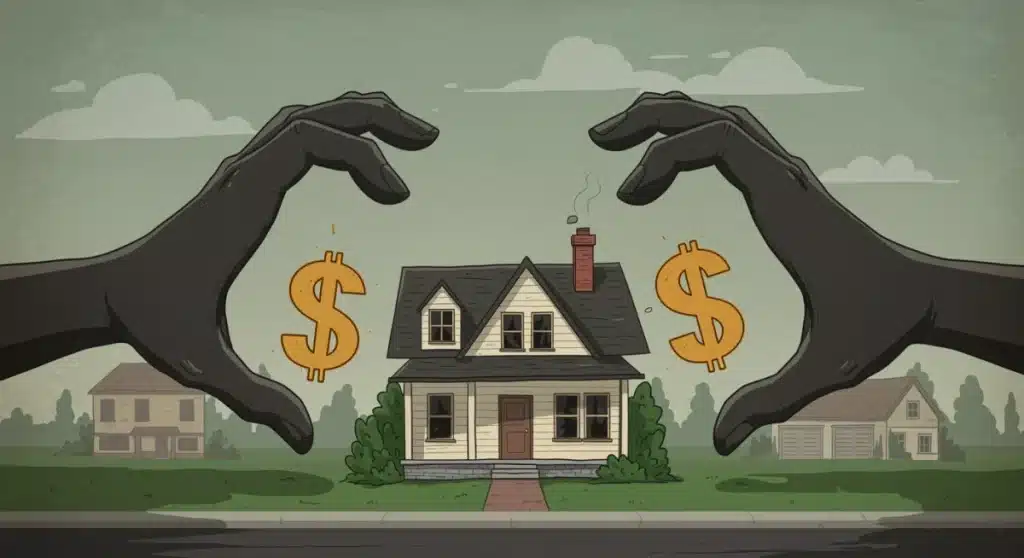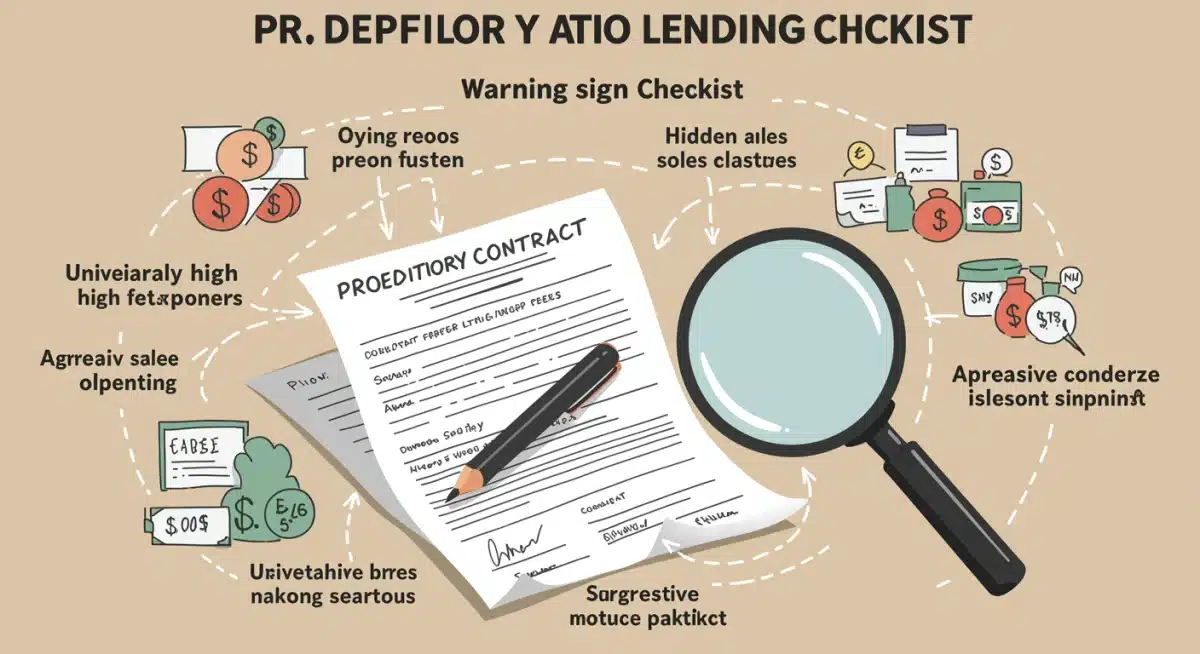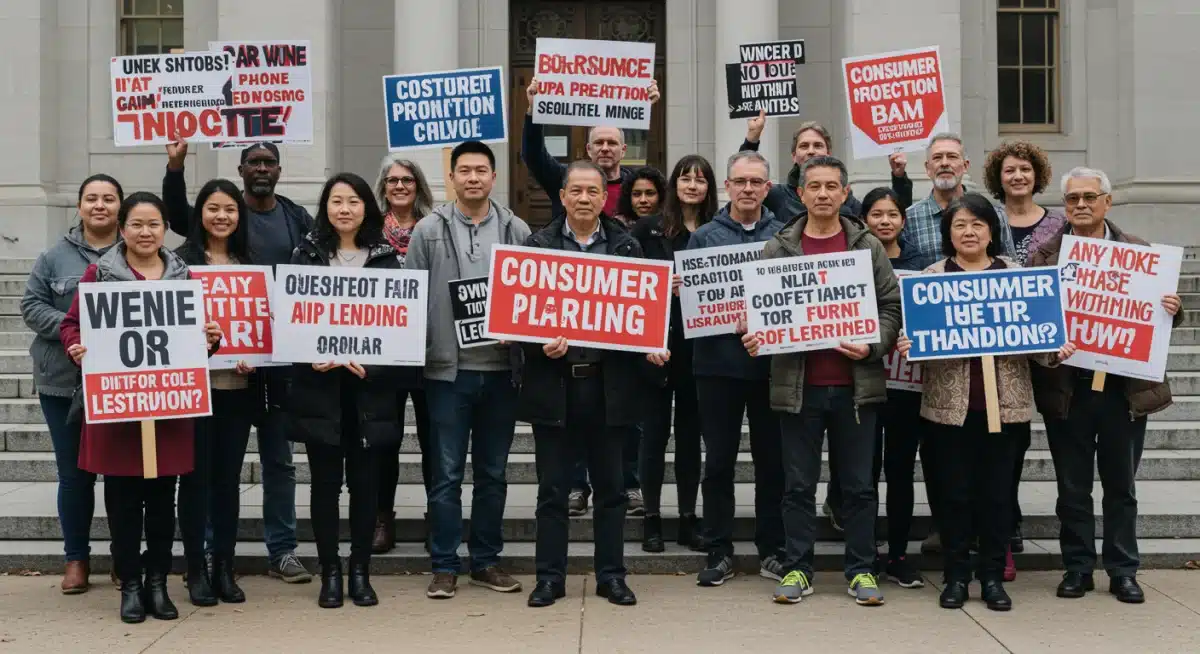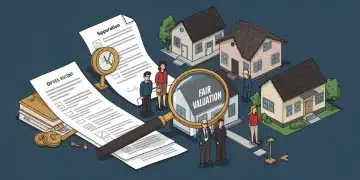Consumer Rights: Navigating Predatory Lending in US Housing Market

Latest developments on Consumer Rights: Navigating Predatory Lending Practices in the Current Estados Unidos Housing Market expose critical issues and offer vital insights for homeowners, emphasizing prevention and legal recourse against deceptive financial schemes.
Consumer Rights: Navigating Predatory Lending Practices in the Current Estados Unidos Housing Market is shaping today’s agenda with new details emerging from consumer advocacy groups and government oversight bodies. This update prioritizes what has changed, why it matters, and what to watch next, in a clear news format, as predatory lending continues to pose significant threats to financial stability for many Americans.
Understanding Predatory Lending in Today’s Housing Market
Predatory lending refers to unscrupulous practices by lenders that benefit them while harming borrowers, often targeting vulnerable populations. In the current United States housing market, characterized by fluctuating interest rates and competitive demand, these practices are becoming increasingly sophisticated and harder to detect, leading to significant financial distress for unsuspecting individuals and families.
Authorities confirmed new timelines and outlined initial impacts across regions, noting a concerning rise in complaints related to deceptive loan terms and inflated fees. Statements from consumer protection agencies indicate short-term adjustments in regulatory oversight and a clearer pathway for subsequent decisions aimed at bolstering consumer safeguards. The pervasive nature of these schemes demands immediate attention and informed action from potential homebuyers and existing homeowners.
Defining the Scope of Predatory Practices
- Exorbitant Fees: Lenders charge excessively high fees, often hidden or not fully disclosed, which can significantly increase the cost of a loan.
- Hidden Clauses: Loan agreements contain complex and often misleading terms that borrowers do not fully understand, leading to unexpected financial burdens.
- Aggressive Sales Tactics: Lenders pressure borrowers into taking out loans they don’t need or can’t afford, often through misleading promises or false urgency.
- Loan Flipping: Repeated refinancing of a loan, often with no real benefit to the borrower, solely to generate new fees and charges for the lender.
- Equity Stripping: A practice where lenders provide loans based on the equity in a home rather than the borrower’s ability to repay, often resulting in foreclosure.
The landscape of predatory lending is constantly evolving, making it crucial for consumers to be vigilant and informed. Early detection and understanding of these tactics are the first lines of defense against falling victim to financially devastating schemes. The current environment, marked by economic uncertainty, provides fertile ground for these illicit activities to flourish, making consumer education paramount.
Identifying Red Flags: How to Spot a Predatory Lender
Spotting a predatory lender can be challenging, as their tactics are often designed to appear legitimate. However, several key indicators can help consumers identify and avoid these harmful practices. Vigilance and a critical eye when reviewing loan offers are essential to safeguard one’s financial future in the dynamic US housing market.
Key data points clarify the scope and sequence of events leading to consumer detriment. Markets and local communities reacted as details became public, with agencies coordinating responses according to established protocols. It is now more important than ever for individuals to be equipped with the knowledge to protect themselves from potentially ruinous financial agreements. Being aware of these warning signs can prevent significant financial losses and emotional distress.

Warning Signs of Unfair Lending
One of the most common red flags is being pressured to sign documents immediately without sufficient time for review or legal counsel. Legitimate lenders encourage due diligence and transparency. Another major indicator is a lender who insists on including optional services, such as credit insurance, into the loan package without clearly explaining that these are not mandatory. These add-ons often inflate the total cost of the loan significantly.
Additionally, watch out for loan offers that seem too good to be true, especially if they come with unusually low introductory rates that quickly adjust to unaffordable levels. Lenders who do not verify your income or repayment ability should also raise suspicion, as this often indicates they are more interested in seizing your property than ensuring your financial well-being. Always question any lender who discourages you from talking to a lawyer or a housing counselor.
A predatory lender might also attempt to disguise the true Annual Percentage Rate (APR) by breaking down fees into smaller, less noticeable amounts or by using complex calculations that are difficult for an average consumer to understand. Transparency is a hallmark of ethical lending, and any obfuscation should be a clear warning sign. Understanding these nuances can save consumers from detrimental financial traps.
Protections in Place: Federal and State Regulations
In response to the pervasive issue of predatory lending, both federal and state governments have enacted various regulations designed to protect consumers. These laws aim to ensure transparency, fairness, and accountability in the lending industry. However, the effectiveness of these protections often depends on consumer awareness and proactive enforcement by regulatory bodies.
Direct quotations and attributed summaries outline positions, obligations, and next steps for both lenders and borrowers. Independent experts assess the credibility and potential outcomes under multiple scenarios, highlighting the ongoing battle against deceptive practices. Despite these efforts, the innovative nature of predatory lenders means consumers must remain informed about their rights and available legal avenues.
Key Federal Protections
- Truth in Lending Act (TILA): Requires lenders to disclose loan terms and costs clearly and completely, including the APR, finance charges, and total payments.
- Home Ownership and Equity Protection Act (HOEPA): Provides additional protections for high-cost mortgages, including restrictions on certain loan terms and mandatory counseling for borrowers.
- Dodd-Frank Wall Street Reform and Consumer Protection Act: Established the Consumer Financial Protection Bureau (CFPB) with broad authority to regulate financial products and services, including mortgage lending.
State laws often complement federal regulations, offering additional layers of protection. Many states have specific statutes against usury, which cap interest rates, and laws prohibiting specific predatory practices like loan flipping or equity stripping. For example, some states require a cooling-off period before a mortgage can be finalized, allowing borrowers more time to reconsider. Understanding these layered protections is crucial for effective self-advocacy.
Despite these robust frameworks, predatory lenders continue to find loopholes or target consumers who are unaware of their rights. This underscores the importance of seeking professional advice from housing counselors or legal experts before committing to any mortgage agreement. These professionals can help interpret complex terms and identify potentially harmful clauses, ensuring that consumers are fully protected.
Seeking Assistance: Resources for Affected Consumers
For consumers who suspect they have been victims of predatory lending, numerous resources are available to provide assistance, guidance, and legal support. Acting quickly is paramount, as delays can complicate efforts to rectify the situation. These resources play a critical role in empowering individuals to fight back against unfair financial practices and seek appropriate remedies.
Practical implications remain limited to specific areas while broader effects depend on forthcoming decisions and compliance windows. However, for those directly affected, immediate action is often necessary. Connecting with the right support networks can make a significant difference in mitigating financial damage and navigating the complex legal landscape associated with predatory lending.
Where to Find Help
- Consumer Financial Protection Bureau (CFPB): Offers a wealth of information on consumer rights and allows individuals to submit complaints about financial products and services.
- Housing Counselors: HUD-approved housing counseling agencies provide free or low-cost advice on buying a home, avoiding foreclosure, and understanding mortgage terms.
- State Attorneys General Offices: Many state AGs have dedicated consumer protection divisions that investigate and prosecute predatory lending cases.
- Legal Aid Societies: Provide free legal services to low-income individuals who cannot afford an attorney, often specializing in consumer protection and housing law.
Additionally, various non-profit organizations and community groups offer support programs, workshops, and advocacy services for victims of predatory lending. These organizations often have a deep understanding of local laws and specific predatory schemes prevalent in their areas, providing targeted and effective assistance. Reaching out to these entities can provide a crucial lifeline for those facing financial hardship due to deceptive lending. Their expertise can help unravel complex loan agreements and guide individuals through the process of seeking justice.
The Impact of Predatory Lending on Communities and the Economy
The repercussions of predatory lending extend far beyond individual borrowers, significantly impacting entire communities and the broader economy. When numerous homeowners fall victim to these practices, it can lead to increased foreclosures, reduced property values, and a general decline in neighborhood stability. This ripple effect can undermine economic growth and exacerbate social inequalities, particularly in vulnerable areas.
The current United States housing market faces unique challenges, making it particularly susceptible to the widespread effects of predatory lending. The loss of home equity, a primary source of wealth for many families, can have long-lasting consequences, affecting retirement plans, educational opportunities, and overall financial security. These practices erode trust in financial institutions and create a climate of fear and uncertainty within the housing sector.
Economic and Social Repercussions
One of the most visible impacts is the destabilization of local housing markets. A surge in foreclosures due to predatory loans can flood the market with distressed properties, driving down home values for everyone. This not only harms affected homeowners but also those who have maintained their mortgages responsibly, as their property values diminish. This can lead to a cycle of economic decline in affected neighborhoods.
Moreover, predatory lending disproportionately affects minority and low-income communities, deepening existing wealth disparities. These communities are often targeted by unscrupulous lenders due to a lack of financial literacy or limited access to traditional credit. The resulting financial exploitation can trap families in cycles of debt, making it difficult to build generational wealth and achieve economic mobility. This systemic issue requires a multi-faceted approach to address its root causes and protect vulnerable populations.
The broader economy also suffers from reduced consumer spending and investment when a significant portion of the population is burdened by unsustainable debt. Confidence in the financial system erodes, potentially leading to stricter lending standards for all, even those with good credit. This creates a challenging environment for economic recovery and growth, highlighting the need for robust regulatory oversight and consumer advocacy.

Preventative Measures: Empowering Consumers with Knowledge
Empowering consumers with knowledge is perhaps the most effective preventative measure against predatory lending. Education about financial literacy, mortgage terms, and consumer rights can equip individuals to make informed decisions and recognize deceptive practices before they cause harm. Proactive learning and critical evaluation of financial offers are essential in today’s complex housing market.
As the landscape of predatory lending housing practices continues to evolve, staying informed is not just beneficial, but necessary. Many organizations offer free educational resources and workshops designed to help consumers understand the intricacies of mortgage agreements, interest rates, and various loan products. These initiatives aim to demystify the home buying process and highlight potential pitfalls, ensuring that consumers are well-prepared to navigate the market safely.
Essential Steps for Consumer Protection
- Research Lenders Thoroughly: Before committing to any loan, investigate the lender’s reputation, read reviews, and check for any complaints filed with regulatory bodies.
- Understand All Loan Terms: Do not sign anything you do not fully comprehend. Ask questions, seek clarification, and consider having a trusted advisor review the documents.
- Shop Around for the Best Rates: Compare offers from multiple lenders to ensure you are getting competitive rates and terms. Be wary of lenders who discourage comparison shopping.
- Get Professional Advice: Consult with a HUD-approved housing counselor or an independent attorney before finalizing a mortgage. Their expertise can uncover hidden risks.
Furthermore, staying updated on current news and alerts from consumer protection agencies can provide timely warnings about new predatory schemes. These agencies often publish reports and advisories on emerging threats, helping consumers to remain vigilant. Knowledge is power, and in the context of predatory lending, it is the strongest shield against financial exploitation. By taking these preventative steps, consumers can significantly reduce their risk of falling victim and secure their financial future.
Key Aspect |
Brief Description > |
|---|---|
Definition |
Unscrupulous lending practices that exploit borrowers for lender’s gain. |
Red Flags |
High fees, hidden clauses, aggressive sales, loan flipping, equity stripping. |
Protections |
Federal laws (TILA, HOEPA, Dodd-Frank) and state-specific regulations. |
Resources |
CFPB, housing counselors, State AGs, Legal Aid Societies for assistance. |
Frequently Asked Questions About Predatory Lending
Predatory lending involves unfair, deceptive, or fraudulent practices by lenders that prioritize their gain over the borrower’s ability to repay, often leading to financial harm. This includes excessive fees, undisclosed terms, and aggressive sales tactics, especially prevalent in the current housing market.
Look for red flags like unusually high interest rates or fees, pressure to sign immediately, hidden clauses in complex documents, or a lender who discourages legal advice. Always compare offers and verify the lender’s reputation to avoid predatory lending housing traps.
Key federal protections include the Truth in Lending Act (TILA), the Home Ownership and Equity Protection Act (HOEPA), and the Dodd-Frank Act, which established the CFPB. These laws mandate transparency and prohibit certain unfair practices in mortgage lending.
If you suspect predatory lending, contact the Consumer Financial Protection Bureau (CFPB), HUD-approved housing counselors, your State Attorney General’s office, or a local Legal Aid Society. Timely action is crucial for resolution and consumer rights protection.
Predatory lending leads to increased foreclosures, reduced property values, and destabilized neighborhoods. It disproportionately affects vulnerable communities, exacerbating wealth disparities and eroding trust in financial systems, impacting the overall economy.
What this means
The ongoing threat of predatory lending practices in the US housing market underscores the critical need for heightened consumer awareness and robust protective measures. Readers must actively engage with educational resources, understand their rights, and seek professional guidance when navigating mortgage agreements. Vigilance now will define the financial stability of homeowners and the integrity of the housing market in the coming years, shaping broader economic health and individual prosperity.





